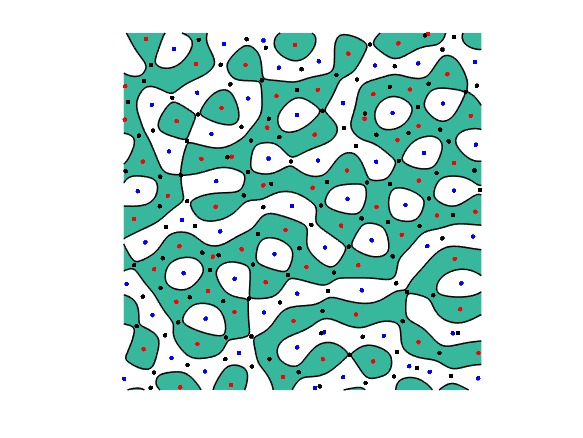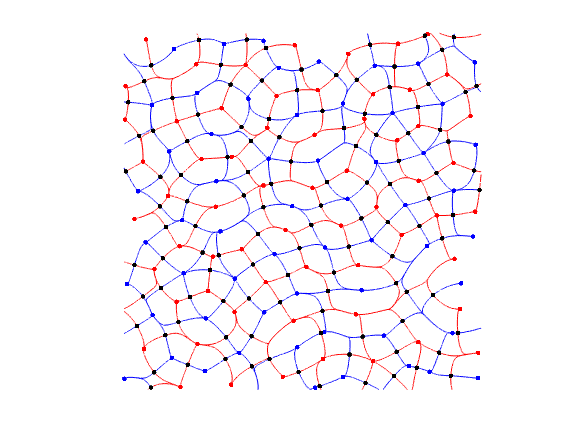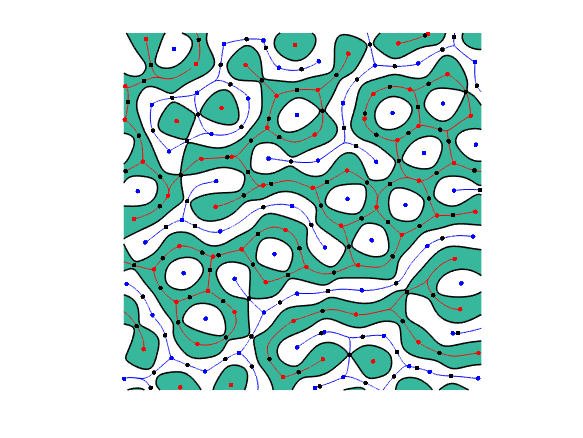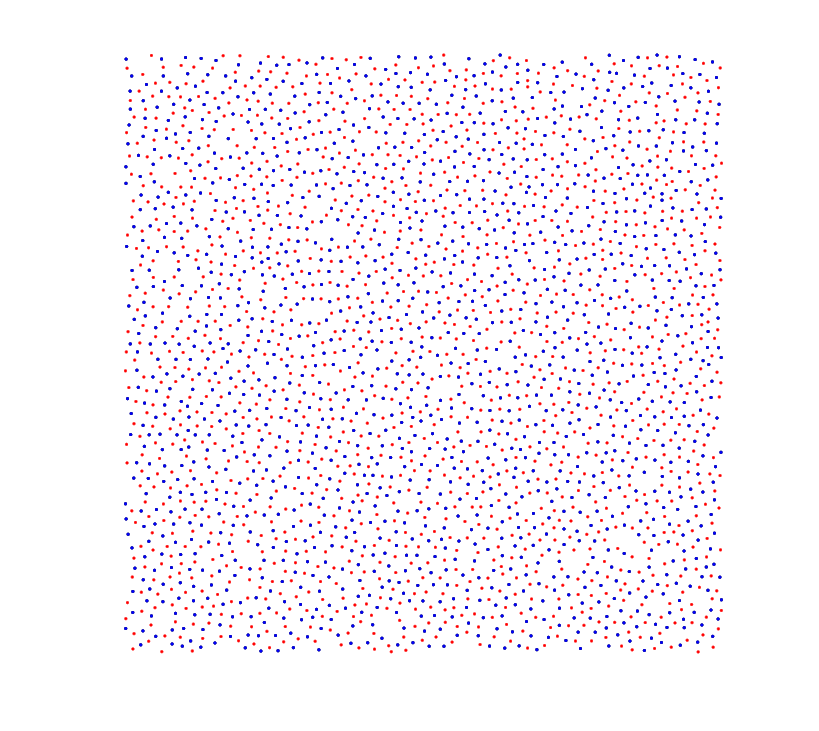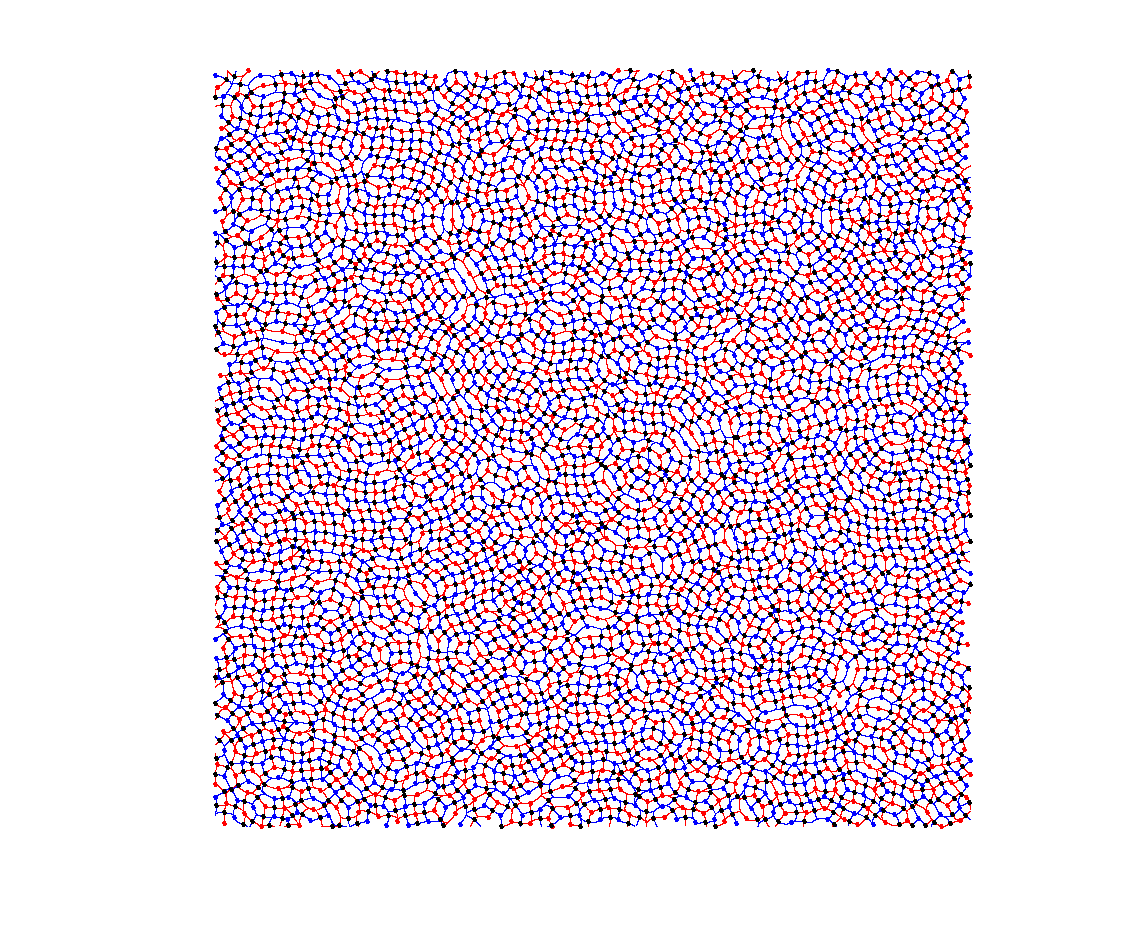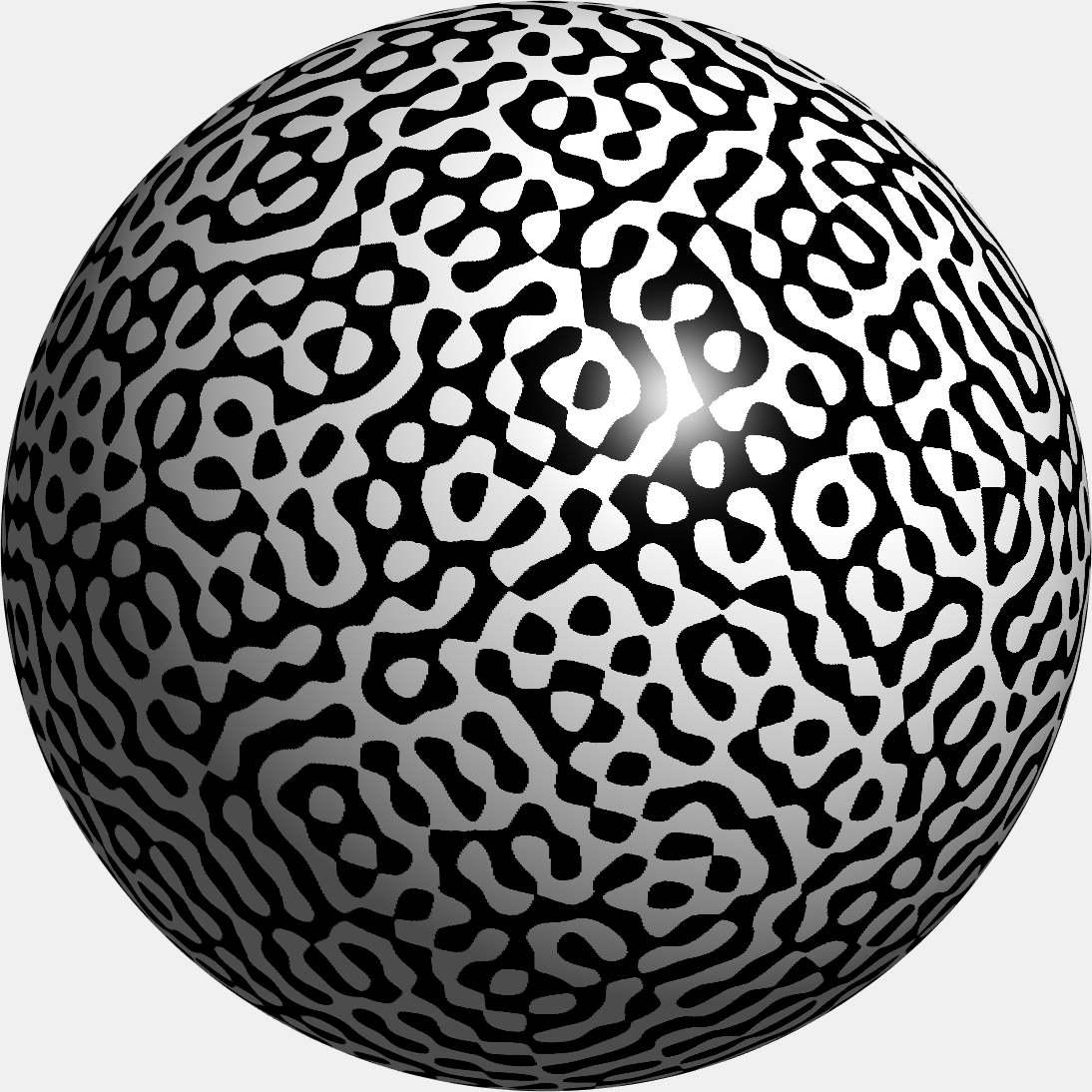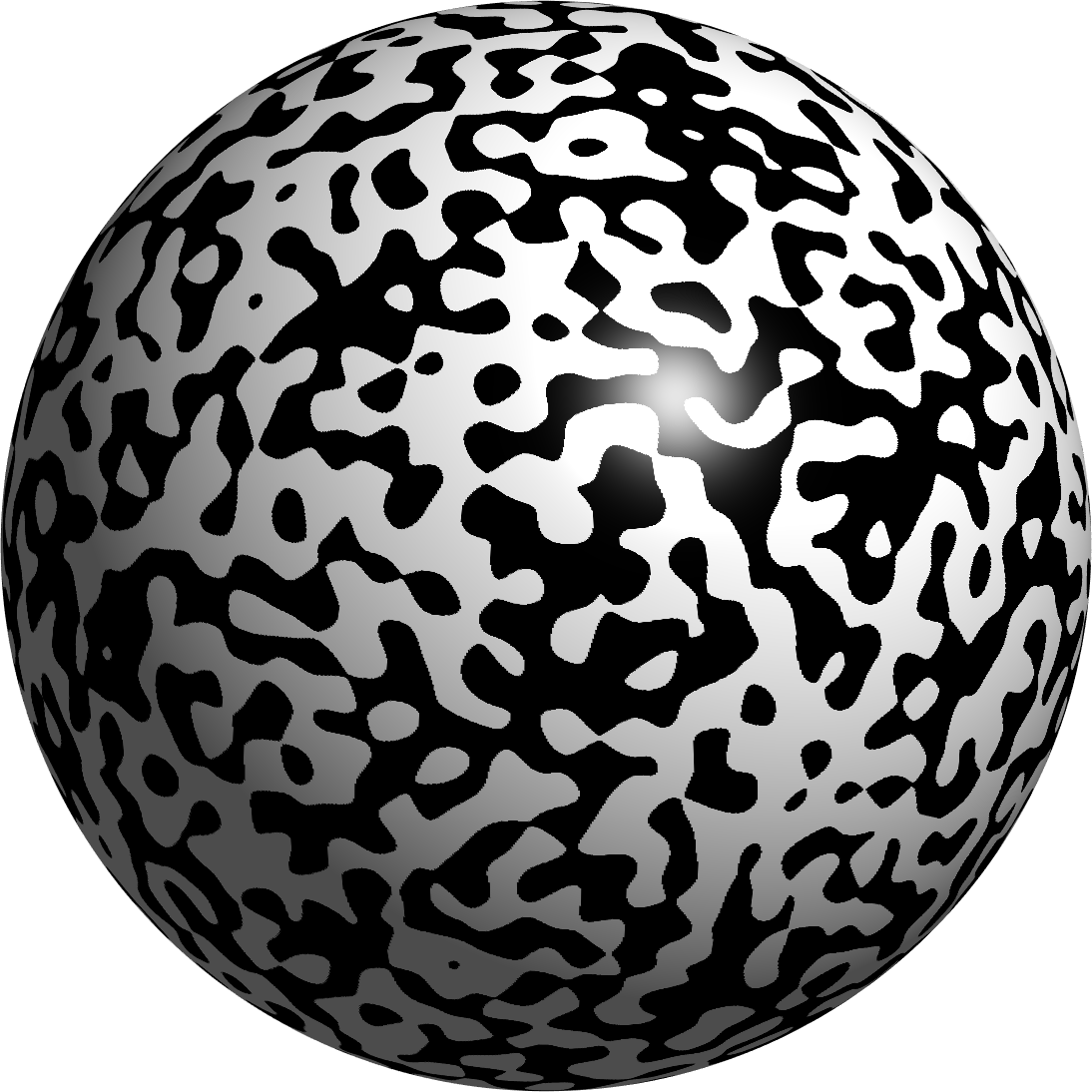D. Beliaev, A. Shekhar, V. Margarint Continuity of Zero-Hitting Times of Bessel
Processes and Welding Homeomorphisms of SLE
Latin American Journal of Probability and Mathematical Statistics.
Open access.
Available at: arXiv
Abstract
We consider a family of Bessel Processes that depend on the starting point
and dimension ,
but are driven by the same Brownian motion. Our main result is that almost surely the first
time a process hits 0 is jointly continuous in and
, provided .
As an application, we show that the SLE() welding
homeomorphism is continuous in for .
Our motivation behind this is to study the well known problem of the continuity of
SLE() in .
The main tool in our proofs is random walks with increments distributed as infinite mean Inverse-Gamma laws.
D. Beliaev, V. Cammarota, I. Wigman No repulsion between critical points for planar Gaussian random fields
Electronic Communications in Probability.
Open access.
Available at: arXiv
Abstract
We study the behaviour the point process of critical points of isotropic stationary Gaussian fields. We compute
the main term in the asymptotic expansion of the two-point correlation function near the diagonal. Our main result
could be interpreted as a statement that for a 'generic' field the critical points neither repel no attract each other.
Our analysis also allows to study how the short-range behaviour of critical points depends on their index.
D. Beliaev, R. Maffucci Coupling of stationary fields with application to arithmetic waves
Stochastic Processes and their Applications. Open access.
Available at: arXiv
Abstract
In this paper we obtain a range of quantitative results of the following type: given two centered Gaussian fields
with close covariance kernels we construct a coupling such that the fields are uniformly close on some compact
with probability very close to one. As an application, we show that it is possible to couple arithmetic random
waves so that they converge locally uniformly to the random plane wave and estimate the rate of convergence.
D. Beliaev, M. McAuley, S. Muirhead Fluctuations of the number of excursion sets of planar Gaussian field
Probability and Mathematical Physics.
Open access.
Available at: arXiv
Abstract
The number of connected components of the excursion set above a level (or level set at ) of a
smooth planar Gaussian field in the ball of radius is known to have mean of order for any .
We show that for certain fields with positive spectral density near the origin (including the Bargmann-Fock field),
and for certain values of , these random variables have fluctuations of order at
least , and hence, variance of order at least .
In particular this holds for excursion sets when is in some neighbourhood of zero, and it holds for excursion/level sets when
is sufficiently large. We prove stronger fluctuation lower bounds of order , , in the case that the spectral density has a
singularity at the origin. Finally we show that the number of excursion/level sets for the random plane wave at certain levels has
fluctuations of order at least and hence variance of order at least .
We expect that these bounds are of the correct order, at least for generic levels.
D. Beliaev, R. Maffucci Intermediate and small scale limiting theorems for random fields
Communications in Number Theory and Physics.
Published version.
Available at: arXiv
Abstract
In this paper we study the nodal lines of random eigenfunctions of the Laplacian on the torus,
the so called 'arithmetic waves'. To be more precise, we study the number of intersections of the nodal
line with a straight interval in a given direction. We are interested in how this number depends on the
length and direction of the interval and the distribution of spectral measure of the random wave. We analyse
the second factorial moment in the short interval regime and the persistence probability in the long interval
regime. We also study relations between the Cilleruelo and Cilleruelo-type fields. We give an explicit coupling
between these fields which on mesoscopic scales preserves the structure of the nodal sets with probability close to one.
D. Beliaev, S. Muirhead, I. Wigman
Mean conservation of nodal volume and connectivity measures for Gaussian ensembles Advances in Mathematics.
Open access.
Available at: arXiv
Abstract
We study in depth the nesting graph and volume distribution of the nodal domains of a Gaussian field,
which have been shown in previous works to exhibit asymptotic laws. A striking link is established
between the asymptotic mean connectivity of a nodal domain (ie the vertex degree in its nesting graph)
and the positivity of the percolation probability of the field, along with a direct dependence of the
average nodal volume on the percolation probability. Our results support the prevailing ansatz that the
mean connectivity and volume of a nodal domain is conserved for generic random fields in dimension
but not in , and are applied
to a number of concrete motivating examples.
D. Beliaev, S. Muirhead, I. Wigman
Russo-Seymour-Welsh estimates for the Kostlan ensemble of random polynomials Annales de l'Institut Henri Poincaré, Probabilités et Statistiques.
Published version.
Available at: arXiv
D. Beliaev, M. McAuley, S. Muirhead Smoothness and monotonicity of the excursion set density of planar Gaussian fields
Electronic Journal of Probability.
Open access. Available at: arXiv
Abstract
Nazarov and Sodin have shown that the number of connected components of the nodal set of a planar Gaussian field in a ball of
radius , normalised by area, converges to a constant. This has been generalised to excursion/level sets at arbitrary levels,
implying the existence of functionals and
that encode the density of excursion/level set components at the level .
We prove that these functionals are continuously differentiable for a wide class of fields. This follows from a more general result which
derives differentiability of the functionals from the decay of the probability of `four-arm events' for the field conditioned to have
a saddle point at the origin. For some fields, including the important special cases of the Random Plane Wave and the Bargmann-Fock field,
we also derive stochastic monotonicity of the conditioned field, which allows us to deduce regions on which and are monotone.
D. Beliaev, T. Lyons, V. Margarint Continuity in κ in SLEκ theory using a constructive method and Rough Path Theory
Annales de l'Institut Henri Poincaré, Probabilités et Statistiques.
Published version.
Available at: arXiv
Abstract
Questions regarding the continuity in of the SLE()
traces and maps appear very naturally in the study of SLE. In order to study the first question,
we consider a natural coupling of SLE traces: for different values of
we use the same Brownian motion. It is very natural to assume that with probability one, SLE()
depends continuously on . It is rather easy to show that SLE is continuous in
the Carathéodory sense, but showing that SLE traces are continuous in the uniform sense is much harder.
In this note we show that for a given sequence ,
for almost every Brownian motion SLE() traces converge locally uniformly.
This result was also recently obtained by Friz, Tran and Yuan using different methods.
In our analysis, we provide a constructive way to study the SLEκ traces for varying parameter
. The argument is based on a new dynamical view on the
approximation of SLE curves by curves driven by a piecewise square root approximation of the Brownian motion.
The second question can be answered naturally in the framework of Rough Path Theory. Using this theory, we prove
that the solutions of the backward Loewner Differential Equation driven by
when started away from the origin are continuous in the -variation topology
in the parameter, for all .
D. Beliaev, S. Muirhead, A. Rivera
A covariance formula for topological events of smooth Gaussian fields
Annals of Probability.
Published version. Available at: arXiv
Abstract
We derive a covariance formula for the class oftopological events' of smooth Gaussian fields on
manifolds; these are events that depend only on the topology of the level sets of the field, for example
(i) crossing events for level or excursion sets,(ii) events measurable with respect to the number of connected
components of level or excursion sets of a given diffeomorphism class, and (iii) persistence events.
As an application of the covariance formula, we derive strong mixing bounds for topological events,
as well as lower concentration inequalities for additive topological functionals (eg the number of
connected components) of the level sets that satisfy a law of large numbers. The covariance formula
also gives an alternate justification of the Harris criterion, which conjecturally describes the boundary
of the percolation university class for level sets of stationary Gaussian fields. Our work is inspired by
a recent paper by Rivera and Vanneuville, in which a correlation inequality was derived for certain topological
events on the plane, as well as by an old result of Piterbarg, in which a similar covariance formula was
established for finite-dimensional Gaussian vectors.
D. Beliaev, M. McAuley, S. Muirhead
On the number of excursion sets of planar Gaussian fields Probability Theory and Related Fields.
Open access
Available at: arXiv
Abstract
The Nazarov-Sodin constant describes the average number of nodal set components of Gaussian fields on large scales.
We generalise this to a functional describing the corresponding number of level set components for arbitrary levels.
Using results from Morse theory, we express this functional as an integral over the level densities of different types
of critical points, and as a result deduce the absolute continuity of the functional as the level varies. We further
give upper and lower bounds showing that the functional is at least bimodal for certain isotropic fields, including
the important special case of the random plane wave.
M. Chavent, A.L. Duncan, P. Rassam, O. Birkholz, J. Hélie, T. Reddy, D. Beliaev, B. Hambly, J. Piehler, C. Kleanthous and M.S.P. Sansom
How nanoscale protein interactions determine the mesoscale dynamic organisation of bacterial outer membrane proteins
Nature Communication 2018 Jul 20;9(1):2846.
Available at Nature: open access
Abstract
The spatiotemporal organisation of membranes is often characterised by the formation of large protein clusters. In Escherichia coli,
outer membrane protein (OMP) clustering leads to OMP islands, the formation of which underpins OMP turnover and drives organisation
across the cell envelope. Modelling how OMP islands form in order to understand their origin and outer membrane behaviour has been
confounded by the inherent difficulties of simulating large numbers of OMPs over meaningful timescales. Here, we overcome these
problems by training a mesoscale model incorporating thousands of OMPs on coarse-grained molecular dynamics simulations. We achieve
simulations over timescales that allow direct comparison to experimental data of OMP behaviour. We show that specific interaction
surfaces between OMPs are key to the formation of OMP clusters, that OMP clusters present a mesh of moving barriers that confine
newly inserted proteins within islands, and that mesoscale simulations recapitulate the restricted diffusion characteristics of OMPs.
A. Krause, D. Beliaev, R. Van Gorder, S. Waters
Bifurcations and Dynamics Emergent From Lattice and Continuum Models of Bioactive Porous Media
International Journal of Bifurcation and Chaos Vol. 28, No. 11, 1830037 (2018).
Published version.
Available at: arXiv
Abstract
In the context of tissue engineering, we recently proposed a lattice model
for a bioactive porous tissue scaffold in order to understand the role of
an active pore network in tissue growth [Lattice and Continuum Modelling
of a Bioactive Porous Tissue Scaffold, preprint, 2017]. This model considered
the scaffold as an evolving lattice of pores, with coupling between local
cell growth in the pores, and fluid flow through the medium. Here we consider
a variant of this lattice model as well as a spatially continuous analogue.
We analyze these models from a dynamical systems perspective emphasizing
qualitative changes in model behaviour as parameters are varied. Depending
on the size of the underlying network, we observe oscillations and steady
states in cell density exhibited in both models. Steady state behaviour can
be described in large cell diffusion regimes via regular asymptotic expansions
in the diffusion parameter. We numerically continue steady state solutions into
intermediate diffusion regimes, where we observe symmetry-breaking bifurcations
to both oscillatory and steady state behaviours that can be explained via local
bifurcations, as well as symmetry-preserving oscillations that do not bifurcate
from steady states. The spatially continuous analogue of the model only exhibits
symmetric steady states and oscillatory solutions, and we conjecture that it is
the finite lattice that gives rise to the more complicated symmetry-breaking
dynamics. We suggest that the origin of both types of oscillations is a nonlocal
reaction-diffusion mechanism mediated by quasi-static fluid flow. Finally we
relate these results back to the original modelling question of how network topology
influences tissue growth in a bioactive porous tissue scaffold.
A. Krause, D. Beliaev, R. Van Gorder, S. Waters
Lattice and Continuum Modelling of a Bioactive Porous Tissue Scaffold
Mathematical Medicine and Biology: A Journal of the IMA, Volume 36, Issue 3, September 2019, Pages 325–360.
Published version.
Available at: arXiv
Abstract
A contemporary procedure to grow artificial tissue is to seed cells onto a porous
biomaterial scaffold and culture it within a perfusion bioreactor to facilitate
the transport of nutrients to growing cells. Typical models of cell growth for
tissue engineering applications make use of spatially homogeneous or spatially
continuous equations to model cell growth, flow of culture medium, nutrient
transport, and their interactions. The network structure of the physical porous
scaffold is often incorporated in an averaged way through parameters in these
models, either phenomenologically or through techniques like mathematical
homogenization. We derive a model on a simple square grid lattice to demonstrate
the importance of explicitly modelling the network structure of the porous scaffold,
and compare results from this model with those from a modified continuum model from
the literature. We capture two-way coupling between cell growth and fluid flow by
allowing cells to block pores, and by allowing the shear stress of the fluid to
affect cell growth and death. We explore a range of parameters for both models,
and demonstrate quantitative and qualitative differences between predictions from
each of these approaches, including spatial pattern formation on different timescales
and local oscillations in cell density present only in the lattice model. These
results suggest that for some parameter regimes, corresponding to specific cell
types and scaffold geometries, the lattice model gives qualitatively different
model predictions than typical continuum models.
D. Beliaev, S. Muirhead. Discretisation schemes for level sets of planar Gaussian fields
Communications in Mathematical Physics, May 2018, Volume 359, Issue 3, pp 869–913
Available at Springer: open access
Abstract
We study four discretisation schemes that extract information about level sets of planar Gaussian
fields. Each scheme recovers information up to different level of precision, and each requires
a maximum mesh-size in order to be valid with high probability. The first two schemes are
generalisations and enhancements of similar schemes that have appeared in the literature;
these give complete topological information about the level sets on either a local or global
scale. As an application, we improve recent results on Russo-Seymour-Welsh estimates for the
nodal set of positively-correlated planar Gaussian fields. The third and fourth schemes are,
to the best of our knowledge, completely new. The third scheme is specific to the nodal set of
the random plane wave, and provides global topological information about the nodal set up to
`visible ambiguities'. The fourth scheme gives an approximation of the Nazarov-Sodin constant
for planar Gaussian fields.
D. Beliaev, I. Wigman. Volume distribution of nodal domains of random band-limited functions, Probability Theory and Related Fields.
Available at Springer: open access
Abstract
We study the volume distribution of nodal domains of random band-limited functions on generic
manifolds, and find that in the high energy limit a typical instance obeys a deterministic
universal law, independent of the manifold. Some of the basic qualitative properties of this
law, such as its support, monotonicity and continuity of the cumulative probability function,
are established.
D. Grebenkov and D. Beliaev
How anisotropy beats fractality in two-dimensional on-lattice DLA growth , Physical Review E. October 2017, Vol. 96(4) 042159.
Published version.
ArXiv version.
Abstract
We study the fractal structure of Diffusion-Limited Aggregation (DLA)
clusters on the square lattice by extensive numerical simulations (with
clusters having up to 108 particles). We observe that DLA clusters undergo
strongly anisotropic growth, with the maximal growth rate along the axes.
The naive scaling limit of a DLA cluster by its diameter is thus
deterministic and one-dimensional. At the same time, on all scales from
the particle size to the size of the entire cluster it has non-trivial
box-counting fractal dimension which corresponds to the overall growth
rate which, in turn, is smaller than the growth rate along the axes. This
suggests that the fractal nature of the lattice DLA should be understood
in terms of fluctuations around one-dimensional backbone of the cluster.
D. Beliaev, V. Cammarota, I. Wigman
Two point function for critical points of a random plane wave
International Mathematics Research Notices, Volume 2019, Issue 9, May 2019, Pages 2661–2689.
Available at OUP: open access
Abstract
Random plane wave is conjectured to be a universal model for high-energy
eigenfunctions of the Laplace operator on generic compact Riemanian manifolds.
This is known to be true on average. In the present paper we discuss one of
important geometric observable: critical points. We first compute one-point
function for the critical point process, in particular we compute the expected
number of critical points inside any open set. After that we compute the
short-range asymptotic behaviour of the two-point function. This gives an
unexpected result that the second factorial moment of the number of critical
points in a small disc scales as the fourth power of the radius.
D. Beliaev, B. Duplantier, and M. Zinsmeister. Integral means spectrum of whole-plane SLE
Communications in Mathematical Physics. July 2017, Volume 353, Issue 1, pages 119–133.
Available at Springer: Open access
Abstract
We complete the mathematical analysis of the fine structure of harmonic measure on SLE curves
that was initiated by Beliaev and Smirnov, as described by the averaged integral means spectrum.
For the unbounded version of whole-plane SLE as studied by Duplantier, Nguyen, Nguyen and Zinsmeister,
and Loutsenko and Yermolayeva, a phase transition has been shown to occur for high enough
moments from the bulk spectrum towards a novel spectrum related to the point at infinity.
For the bounded version of whole-plane SLE studied here, a similar transition phenomenon,
now associated with the SLE origin, is proved to exist for low enough moments, but we show
that it is superseded by the earlier occurrence of the transition to the SLE tip spectrum.
D. Grebenkov, D. Beliaev, and P. Jones.
A Multiscale Guide to Brownian Motion,
Journal of Physics A: Mathematical and Theoretical. 49 (2015) 043001
Available at: arXiv
Abstract
We revise the Levy's construction of Brownian motion as a simple
though rigorous approach to operate with various Gaussian processes.
A Brownian path is explicitly constructed as a linear combination of
wavelet-based "geometrical features" at multiple length scales with
random weights. Such a wavelet representation gives a closed formula
mapping of the unit interval onto the functional space of Brownian
paths. This formula elucidates many classical results about Brownian
motion (e.g., non-differentiability of its path), providing intuitive
feeling for non-mathematicians. The illustrative character of the
wavelet representation, along with the simple structure of the
underlying probability space, is different from the usual presentation
of most classical textbooks. Similar concepts are discussed for
Brownian bridge, fractional Brownian motion, Ornstein-Uhlenbeck
process, Gaussian free field, and fractional Gaussian fields. Wavelet
representations and dyadic decompositions form the basis of many
highly efficient numerical methods to simulate Gaussian processes and
fields, including Brownian motion and other diffusive processes in
confining domains.
D.Beliaev, Z. Kereta, On Bogomolny-Schmit conjecture,
Journal of Physics A: Mathematical and Theoretical,
November 2013 46.45 (2013): 455003
available at: arXiv
Abstract
Bogomolny and Schmit proposed that the critical edge percolation on the square lattice is a good model for the nodal domains of a
random plane wave. Based on this they made a conjecture about the number of nodal domains. Recent computer experiments showed that
the mean number of clusters per vertex and the mean number of nodal domains per unit area are very close but different. Since the
original argument was mostly supported by numerics, it was believed that the percolation model is wrong. In this paper we give some
numerical evidence in favour of the percolation model.
D.Beliaev, F.Johansson Viklund, Some remarks on SLE bubbles and Schramm's two-point observable, Communications in Mathematical Physics, June 2013, Volume 320, Issue 2, pp 379-394,
available at: arXiv
Abstract
Simmons and Cardy recently predicted a formula for the probability that the chordal SLE(8/3) path passes to
the left of two points in the upper half-plane. In this paper we give a rigorous proof of their formula. Starting
from this result, we derive explicit expressions for several natural connectivity functions for SLE(8/3) bubbles conditioned
to be of macroscopic size. By passing to a limit with such a bubble we construct a certain chordal restriction measure and
in this way obtain a proof of a formula for the probability that two given points are between two commuting SLE(8/3) paths.
The one-point version of this result has been predicted by Gamsa and Cardy. Finally, we derive an integral formula for the
second moment of the area of an SLE(8/3) bubble conditioned to have radius 1. We evaluate the area integral numerically and
relate its value to a hypothesis that the area follows the Airy distribution.
D.Beliaev, K.Izyurov, A proof of factorization formula for critical percolation, Communications in Mathematical physics. 310 (2012), no. 3, 611-623,
available at: arXiv
Abstract
We give mathematical proofs to a number of statements which appeared in the series of papers
by Kleban, Simmons and Ziff where they computed the probabilities of several percolation crossing events.
D.Beliaev, S.Smirnov, Random Conformal Snowflakes, Annals of Mathematics 172 (2010), 597--615.
PDF file.
D.Beliaev, E.Järvenpää, M.Järvenpää, A.Käenmäki, T.Rajala, S.Smirnov, V.Suomala, Packing dimension of mean porous measures,
J. Lond. Math. Soc. (2) 80 (2009), no. 2, 514--530.,available at: arXiv
Abstract
We prove that the packing dimension of any mean porous Radon measure on may be estimated from above by a
function which depends on mean porosity. The upper bound tends to as mean porosity tends to its maximum
value.
Quite surprisingly, it turns out that mean porous measures are not necessarily approximable by mean porous sets.
We verify this by constructing an example of a mean porous measure on
such that for all mean porous sets
.
D.Beliaev, S.Smirnov, Harmonic measure and SLE. Comm. Math. Phys. 290 (2009), no. 2, 577--595.
PDF file.
Abstract
The motivation for this paper is twofold: to study multifractal spectrum
of the harmonic measure and to better describe the geometry of Schramm's
SLE curves. Our main result is the rigorous computation the average spectrum of harmonic measure on domains
bounded by SLE curves.
D.Beliaev, Integral means spectrum of random conformal snowflakes, Nonlinearity 21 (2008), no. 7, 1435--1442.
PDF file.
Abstract
In this paper we construct random conformal snowflakes with large integral means spectrum at different points.
These new estimates are significant improvement over previously known lower bound of the universal spectrum.
Our estimates are within 5-10 percent from the conjectured value of the universal spectrum.
D.Beliaev, S.Smirnov, Harmonic measure on fractal sets,
European Congress of Mathematics, 41--59, Eur. Math. Soc., Zürich, 2005.
PDF file.
Abstract
Many problems in complex analysis can be reduced to the evaluation
of the universal spectrum: the supremum of multifractal spectra of harmonic
measures for all planar domains. Its exact value is still unknown, with very
few estimates available. We start with a brief survey of related problems and
available estimates from above. Then we discuss in more detail estimates from
below, describing the search for a fractal domain which attains the maximal
possible spectrum
D.Beliaev, S.Smirnov, On Littlewood's constants,
Bull. London Math. Soc. 37 (2005), no. 5, 719--726.
PDF file.
Abstract
In two papers, Littlewood studied seemingly unrelated constants: (i) the best
such that for any
polynomial of degree
the areal integral of its spherical derivative is at most and
(ii) the extremal growth rate of the length of Green’s equipotentials for simply connected
domains. These two constants are shown to coincide, thus greatly improving known estimates
on .
A.Aleman, D.Beliaev, and H.Hedenmalm,
Real zero polynomials and Pólya-Schur type theorems,
Journal d'Analyse Mathématique, 94 (2004), 49--60.
PDF file.
D.Beliaev, S.Smirnov, On dimension of porous measures,
Math. Ann. 323 (2002), no. 1, 123--141.
PDF file.
The original publication is available
on Springer's LINK at http://link.springer.de/...
D.Beliaev, V.Havin, On the uncertainty principle for M. Riesz potentials, Ark. Mat. 39 (2001), no. 2, 223--243.
PDF file.



